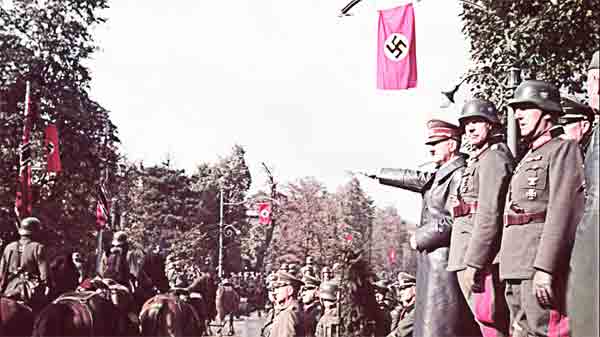
Hitler's armies invaded Poland starting World War II in Europe on September 01, 1939
Hitler's armies invaded Poland starting World War II in Europe: On September 01, 1939 Hitler's armies invaded Poland starting World War II in Europe.
THE EASTERN FRONT
Dive into the bitterly contested, racial, furious battles of the Eastern Europe, where more combatants were killed than in all other theaters combined.
The U.S. involvement in the European theater of operations was mainly confined to Western Europe and Italy, but some of the war’s most savage fighting occurred on the Eastern Front, where the Axis powers had set out to conquer the Balkan Peninsula and the immense reaches of the Soviet Union. More combatants were killed on the Eastern Front than in all other theaters of World War II combined.
These bitterly contested, racial battles (Adolf Hitler had vowed to exterminate the eastern Slavs) prevented Germany from mounting a more resolute defense against Allied armies in Normandy, and later, on the Reich’s western borders.
As early as 1923, when Hitler authored Mein Kampf, he believed Germany’s destiny lay in defeating its historic enemy, France, and pushing eastward into the Soviet Union, exterminating both communism and the Slavic peoples. But he didn’t want to fight both countries at the same time, especially if Great Britain came to the defense of France.
Accordingly, in August 1939, Hitler signed a nonaggression pact with the Soviet Union. The treaty also included a secret agreement to divide Poland, the Baltic States (Latvia, Estonia, and Lithuania), Finland, and Romania into German and Soviet spheres of influence. Neither country fully trusted the other, but the agreement achieved short-term goals for both parties. Germany was free to attack Poland and France without worrying about a Soviet invasion, and the Soviets could take control over parts of eastern Europe without fear of German retaliation.
After Germany invaded Poland in September 1939, Soviet troops moved into parts of eastern Europe, occupying 286,000 square miles of territory containing 20 million people. This action was permitted under the terms of the nonaggression pact, but it endangered Hitler’s plans for expansion eastward. “The sooner Russia is smashed the better”, he told his generals.
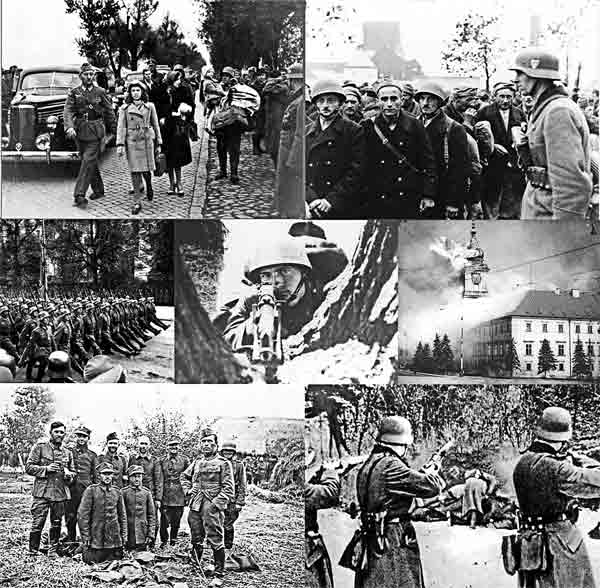
On June 22, 1941, Hitler took his greatest gamble, unleashing Operation Barbarossa, a three million-man invasion of the Soviet Union. The invasion was spectacularly effective in its early stages. By September, the Red Army had sustained some 2.5 million casualties. But it turned out to be a fatal mistake.
The Soviet Union was one of only two countries (the other was the United States) Germany could not defeat. The Red Army was the largest in the world, comprising over 250 divisions, and the Soviet Union was the world’s largest country by area, with vast natural resources. Undaunted, Hitler was confident the Soviet Union would fall to his armies in a matter of months. Its military equipment was outmoded, its generals were inept, and it had great difficulty defeating tiny Finland the previous year. There was also strong opposition to Joseph Stalin’s repressive regime in the Ukraine and other Soviet provinces. “We have only to kick in the door”, Hitler said, “and the whole rotten structure will come crashing down.”
The United States and Great Britain were barely on speaking terms with Stalin’s communist regime but both eventually joined forces with the “Reds” because they shared a common enemy. “Any man or state who fights on against Nazism will have our aid”, Winston Churchill told the British people in a radio address.
The fighting on the Eastern Front was terrible and incessant, brutal beyond belief. Both sides fought with demonic fury - the Germans to crush the hated Slavs, and the Soviets to defend the sacred soil of “Mother Russia”. Atrocities including beheadings and mass rapes occurred daily. Millions of captured soldiers died of exposure and maltreatment. The Germans besieged Leningrad and tried to subdue it by starving its entrapped people.
At Stalingrad, the pivotal battle of World War II, Hitler had ordered that the entire male population of the city of one million be killed and that all females be deported. No battle in history was more ferociously waged. In house-to-house, factory-to-factory fighting, snipers were used to great effect by both sides, and the butcher’s bill ran high. The Axis forces suffered 850,000 casualties and the Soviets 750,000. Stalin considered his losses necessary. The surrender of the city would have been an irreversible victory for the Nazis.
Millions of victims of the German invasion were noncombatants. Jews and Slavic peasants were killed by the German army - the Jews by rifle squads that followed the army. Hitler’s racial crusade against the Slavs would backfire, however, driving potential Nazi collaborators back into the arms of the tyrannical dictator Stalin.
After the Red Army prevented the Wehrmacht from taking Moscow in 1941 and prevailed at Stalingrad - one of the most decisive battles in history - it began a counteroffensive that drove the enemy all the way back to Berlin in 1945. In one of the final stages of the Red offensive, Soviet advances in the summer of 1944 drew away German forces that could have blunted the Allied offensive in Normandy.
The National War WWII Museum / Wikipedia / Encyclopedia Britannica /
History Channel / Encyclopedia USHMM.org (Holocaust Encyclopedia) / The Holocaust Explained.org /
National Archives.gov / Search Films & Photos - Library Of Congress.gov / Franklin D. Roosevelt Presidential Library and Museum.org /
The Atlantic /
Hitler's armies invaded Poland starting World War II in Europe on September 01, 1939 (YouTube) 

President Harry Truman declared V-J Day commemorating formal Japanese surrender to the Allies on September 02, 1945
President Harry Truman declared V-J Day commemorating formal Japanese surrender to the Allies: On September 02, 1945, President Harry Truman declared V-J Day (Victory over Japan Day) commemorating the formal Japanese surrender to the Allies aboard the USS Missouri in Tokyo Bay.
“It was too much death to contemplate, too much savagery and suffering; and in August 1945 no one was counting. For those who had seen the face of battle and been in the camps and under the bombs - and had lived - there was a sense of immense relief.”
The Allied celebrations on Victory in Europe Day (V-E Day), on May 8, 1945, were subdued by the knowledge that war raged on in the Pacific. As the fighting ended in Europe, U.S. troops were drawing a noose around the Japanese home islands. But there were ominous signs that Japan’s fierce resistance would continue.
The battles for Iwo Jima and Okinawa during the first half of 1945 were marked by spectacular carnage, and Americans were chastened by the knowledge that Japan had never surrendered to a foreign power and that no Japanese military unit had surrendered during World War II.
After Okinawa fell to U.S. forces on June 22, 1945, an invasion of the Japanese home islands was set to begin. But before the invasion was to take place, the most destructive war in history came to a shattering and rapid end.
On August 6, the United States dropped the first atomic bomb over Hiroshima, ultimately killing as many as 140,000 people. Two days later, the Soviet Union declared war on Japan.
Then, on August 9, the United States dropped a second atomic bomb over Nagasaki, ultimately killing approximately 70,000.
Finally recognizing that victory was impossible, the Japanese government accepted Allied surrender terms without qualifications on August 14, 1945. That same day, President Harry S. Truman announced from the White House that the Japanese acceptance met the terms laid down at the Potsdam Conference for unconditional surrender. As soon as the news of Japan’s surrender was announced on August 14, celebrations erupted across the United States.
The United Kingdom announced that its official V-J Day would be the next day, August 15, 1945, and Americans exuberantly joined in that day’s merriment, too.
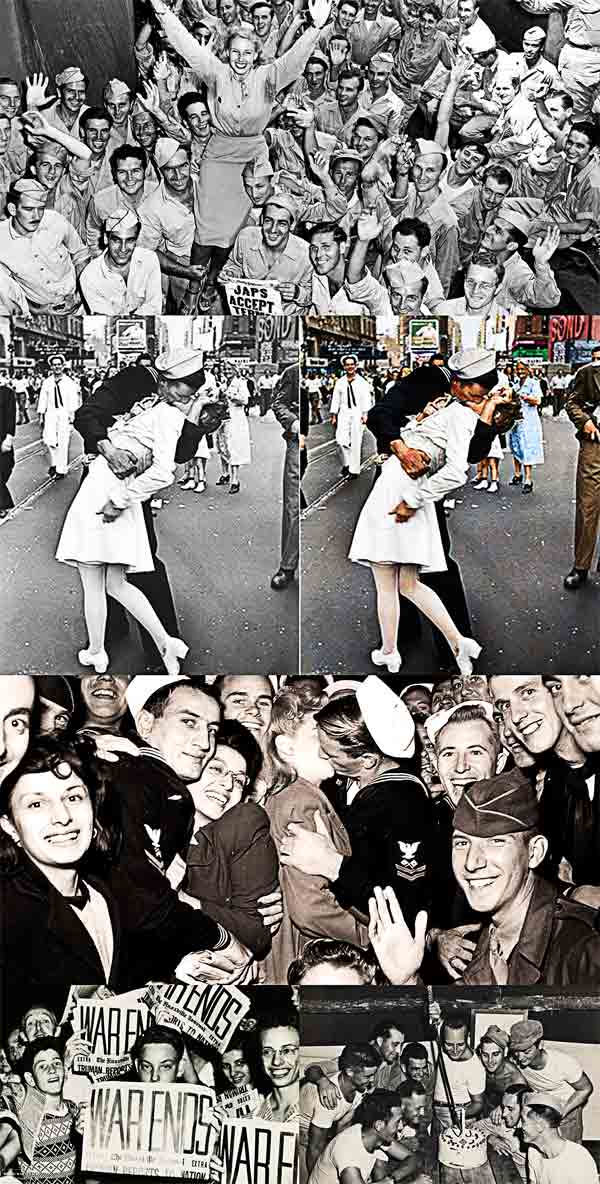
Victory over Japan Day (V-J Day) would officially be celebrated in the United States on the day formal surrender documents were signed aboard the USS Missouri in Tokyo Bay: September 2, 1945.
In New York City’s Times Square, sailors climbed lampposts to unfurl American flags as ticker tape rained down upon the throngs gathered to celebrate the war’s end. In thousands of small towns like North Platte, Nebraska, similar scenes included fireworks, confetti, and impromptu parades down Main Street. In San Francisco, parades celebrated that troops would soon return home through that city.
In Honolulu, marching bands, parades, ticker tape, and blowing papers filled the streets. In backyard celebrations, shirtless veterans drank celebratory toasts in the warm sunlight. Veterans and their girlfriends also crowded into and on top of trucks and cars (some even riding on fenders), waved flags, and excitedly drove through the city, relishing the moment Americans had hoped for since the attack on Pearl Harbor.
Victory over Japan Day (V-J Day) would officially be celebrated in the United States on the day formal surrender documents were signed aboard the USS Missouri in Tokyo Bay: September 2, 1945.
But as welcome as victory over Japan was, the day was bittersweet in light of the war’s destructiveness. More than 400,000 Americans - and an estimated 65 million people worldwide - had died in the conflict. As historian Donald L. Miller, PhD, wrote in his book “The Story of World War II”, “It was too much death to contemplate, too much savagery and suffering; and in August 1945 no one was counting. For those who had seen the face of battle and been in the camps and under the bombs - and had lived - there was a sense of immense relief.” The war was over.
The National War WWII Museum / Wikipedia / Encyclopedia Britannica /
History Channel / National Museum Of The United States NAVY.mil / Center Of Military History United States ARMY.mil /
History Explains Why the U.S. Marks VJ Day as September 2, 1945, Instead of August 15, 1945 - United Service Organizations USO.org /
National Archives.gov / Veterans History Day Book - Library Of Congress.gov / Truman Library.gov /
President Harry Truman declared V-J Day commemorating formal Japanese surrender to the Allies on September 02, 1945 (YouTube) 

Understanding Military Terminology
Radiation Dose
(DOD) The total amount of ionizing radiation absorbed by material or tissues.
See also Exposure Dose.
Joint Publications (JP 3-11) Operations in Chemical, Biological Radiological, and Nuclear Environments - Joint Chiefs of Staff
Radiation Dose
(DOD) Measurement of radiation dose per unit of time.
Joint Publications (JP 3-11) Operations in Chemical, Biological Radiological, and Nuclear Environments - Joint Chiefs of Staff
Radiation Exposure Status
(DOD) Criteria to assist the commander in measuring unit exposure to radiation based on total past cumulative dose, normally expressed in centigray.
See also RES.
Joint Publications (JP 3-11) Operations in Chemical, Biological Radiological, and Nuclear Environments - Joint Chiefs of Staff
Joint Publication - Department of Defense Dictionary of Military and Associated Terms
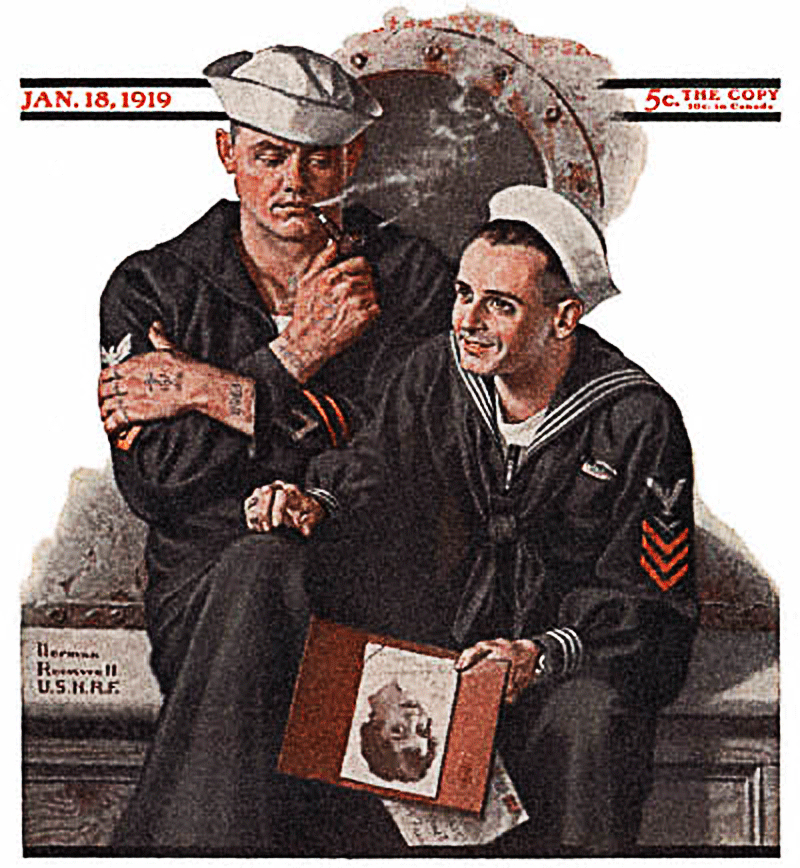
The Old Salt’s Corner

Roadstead
A roadstead is a body of water sheltered from rip currents, spring tides or ocean swell outside a harbor where ships can lie reasonably safely at anchor without dragging or snatching while waiting for their turn to enter a port of call. It can be open or natural, usually - estuary-based, or may be created artificially.
In maritime law, a “known general station for ships, notoriously used as such, and distinguished by the name”. Charts and nautical publications often use roads rather than roadsteads; “Roads” is the earlier term.
In the days of sailing ships, some voyages could only easily be made with a change in wind directionnge of wind in a safe anchorage, such as the Downs or Yarmouth Roads. Daniel Defoe has Robinson Crusoe recall of an early journey in the coastal trade:
“The sixth day of our being at sea we came into Yarmouth Roads; the wind having been contrary, and the weather calm, we had made, and ships would wait for a chabut little way since the storm. Here we were obliged to come to an anchor, and here we lay, the wind continuing contrary, viz., at southwest, for seven or eight days, during which time a great many ships from Newcastle came into the same Roads...”

“I’m Just Sayin”
“The man who never makes a mistake always takes orders from one who does.
No man or woman who tries to pursue an ideal in his or her own way is without enemies.”
~ Daisy Bates

“Thought for the Day”
“Well done is better than well said.”
“Never leave that till tomorrow which you can do today.”
“Lost time is never found again.”
“An investment in knowledge pays the best interest.”
“Some people die at 25 and aren't buried until 75.”
“Guests, like fish, begin to smell after three days.”
“Either write something worth reading or do something worth writing.”
“They who can give up essential liberty to obtain a little temporary safety deserve neither liberty nor safety.”
“Life's tragedy is that we get old too soon and wise too late.”
“A place for everything,
everything in its place.”
“In this world nothing can be said to be certain,
except death and taxes.”
“Three can keep a secret,
if two of them are dead.”
“Tell me and I forget.
Teach me and I remember.
Involve me and I learn.”
“We must, indeed,
all hang together or,
most assuredly,
we shall all hang separately.”
“Without continual growth and progress,
such words as improvement,
achievement,
and success have no meaning.”
~ Benjamin Franklin

“What I Learned”
“Here is no choice but either do or die.”
“Every man dies.
Not every man really lives.”
“The best and most beautiful things in the world cannot be seen or even touched -
They must be felt with the heart.”
“Once you replace negative thoughts with positive ones,
you'll start having positive results.”
“Nothing in life is to be feared,
it is only to be understood.
Now is the time to understand more,
so that we may fear less.”
~ William Wallace
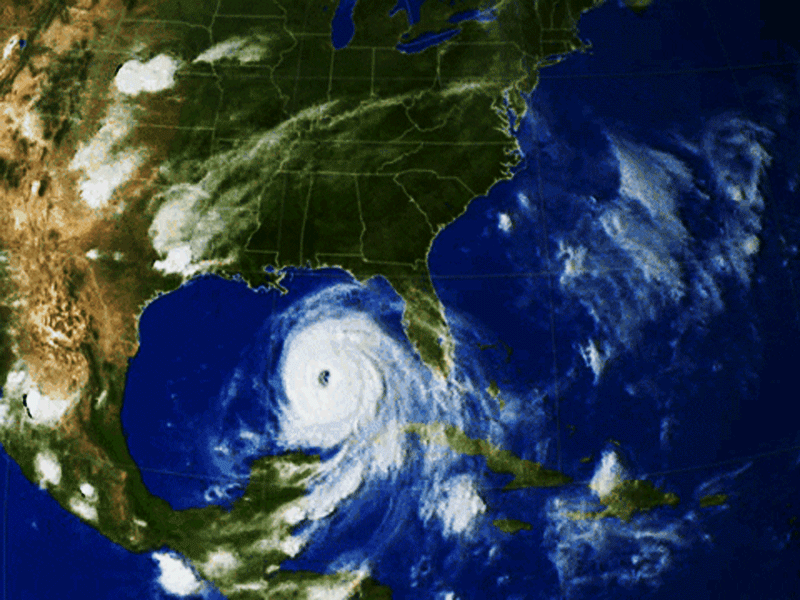 Mr. Answer Man Please Tell Us: How Do Hurricanes Form?
Mr. Answer Man Please Tell Us: How Do Hurricanes Form?
Hurricanes are the most violent storms on Earth. People call these storms by other names, such as typhoons or cyclones, depending on where they occur. The scientific term for all these storms is tropical cyclone. Only tropical cyclones that form over the Atlantic Ocean or eastern Pacific Ocean are called “hurricanes”.
Whatever they are called, tropical cyclones all form the same way.
Tropical cyclones are like giant engines that use warm, moist air as fuel. That is why they form only over warm ocean waters near the equator. The warm, moist air over the ocean rises upward from near the surface. Because this air moves up and away from the surface, there is less air left near the surface. Another way to say the same thing is that the warm air rises, causing an area of lower air pressure below.
Air from surrounding areas with higher air pressure pushes in to the low pressure area. Then that “new” air becomes warm and moist and rises, too. As the warm air continues to rise, the surrounding air swirls in to take its place. As the warmed, moist air rises and cools off, the water in the air forms clouds. The whole system of clouds and wind spins and grows, fed by the ocean's heat and water evaporating from the surface.

Storms that form north of the equator spin counterclockwise. Storms south of the equator spin clockwise. This difference is because of Earth's rotation on its axis.
As the storm system rotates faster and faster, an eye forms in the center. It is very calm and clear in the eye, with very low air pressure. Higher pressure air from above flows down into the eye.
When the winds in the rotating storm reach 39 mph, the storm is called a “tropical storm”. And when the wind speeds reach 74 mph, the storm is officially a “tropical cyclone”, or hurricane.
Tropical cyclones usually weaken when they hit land, because they are no longer being “fed” by the energy from the warm ocean waters. However, they often move far inland, dumping many inches of rain and causing lots of wind damage before they die out completely.
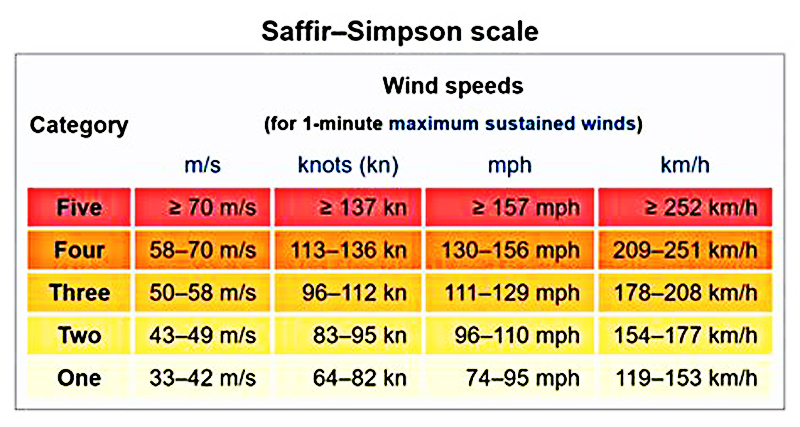
The two GOES satellites keep their eyes on hurricanes from far above Earth's surface—22,300 miles above, to be exact! (Learn more about this kind of orbit.)
These satellites, built by NASA and operated by the National Oceanic and Atmospheric Administration (NOAA), save lives by helping weather forecasters predict and warn people where and when these severe storms will hit land.

Spaceplace.NASA.gov / Tropical Cyclone - Atlantic Wikipedia / Encyclopedia Britannica /
National Oceanic and Atmospheric Administration NOAA.gov / NOAA.gov - Weather.gov /
How Do Hurricanes Form? (YouTube) 

NAVSPEAK aka U.S. Navy Slang
Super Goat: A chief warrant officer.
SUPPO: Supply Officer on ship.
Surge: A ship deployment from its home port usually lasting 3 to 6 months, as can occur outside of the normal cruise cycle due to operational commitments.
Swab: Mop.
Swabbie: Sailor.
SWAG: Sonar's/Scientific Wild Ass Guess.
Swallow The Anchor: Retire.
SWEATEX:
(1) Any evolution or situation, to be performed by an individual, a ship, or even larger unit, subject to scrutiny by a superior, such as a major inspection;.
(2) An evolution that involves one sailor working while his/her superiors are watching and waiting impatiently.
(3) A task that has to be done yesterday.
Sweat Pump(s) / Sweat Pump(s) On Line/ On Overload: See “Sweat The Load.”
Sweat The Load: Personal stress about being able to perform some task; to feel stress about a situation. Ssee Also “The Load”.
Swims: Aviation water survival training. This 2-day class must be completed every few years by pilots and aircrew. Consists of classroom and pool instruction and culminates with the dreaded “Dilbert Dunker” and “Helo Dunker”.
Swinging Dick: Spoken by Marines, and sailors to refer to healthy shipmates while on maneuvers, e.g. “I want every swinging dick on station, right this second.”
Wiktionary.org

Just for you MARINE
Survey: Medical discharge or to effect discharge/retirement of an individual for medical reasons; dispose of an item of government property by reason of unserviceability.
Swab: Mop; also pejorative for sailor, so named because sailors of wooden ships had to swab the decks to keep them from warping.
Swamp-ass : Unpleasant collection of sweat soaking undergarments.
Swinging Dick: Vulgarity for male Marine, usually used as “every swinging dick” to emphasize an order to a whole group instead of individual(s).
Swoop: Make a long trip in a short period of time, usually in reference to returning to post after liberty to avoid an Unauthorized Absence (UA) status.
Sympathy Chit: Voucher sarcastically authorizing the recipient sympathy from others.
Wikipedia.org

Naval Aviation Squadron Nicknames
HSM-75 Helicopter Maritime Strike (HSM) Squadron SEVEN FIVE - nicknamed the “Wolfpack”
United States Navy - Marine Corps Commander, Helicopter Maritime Strike Wing Pacific - Naval Air Station North Island, Part of Naval Base Coronado San Diego, California. / HSL-45: October 03, 1986 - February 2011 / HSM-75: February 2011 - present

Where Did That Saying Come From?
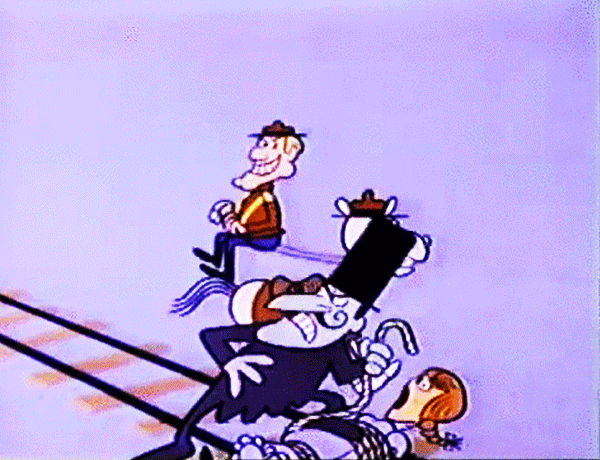
“A friend in need is a friend indeed:”
Meaning: There are various interpretations of the meaning of 'a friend in need is a friend indeed'.
Firstly, is it 'a friend in need is a friend indeed' or 'a friend in need is a friend in deed'?
Secondly, is it 'a friend (when you are) in need' or 'a friend (who is) in need'? If the former, then the phrase means:
'someone who helps you when you are in need is a true friend'. If the latter, it is 'someone who needs your help becomes especially friendly in order to obtain it'.
So, that gives us four options:
1. A friend, (when you are) in need, is indeed a true friend. ('indeed')
2. A friend, (when you are) in need, is someone who is prepared to act to show it ('in deed')
3. A friend, (who is) in need, is indeed a true friend. ('indeed')
4. A friend, (who is) in need, is someone who is prepared to act to show it ('in deed')
The original meaning can be resolved to some degree by the documentary evidence. Nevertheless, although most people have no doubt that No.1 is correct. There is no unambiguous right or wrong here and this is a phrase the meaning of which we probably infer from the context in which we first hear it.
Whichever of the above options we initially opt for will cement our understanding of the phrase, probably forever.
History: “A friend in need is a friend indeed” is quite an early proverb in the English language and, as such, might be thought to contain the wisdom of the ancients.
History: A version of this proverb was known by the 3rd century BC. Quintus Ennius wrote: 'Amicus certus in re incerta cernitur'. This translates from the Latin as 'a sure friend is known when in difficulty'.
The Oxford Dictionary of Quotations lists it as existing in English from the 11th century. The earliest version I can find is from Caxton's Sonnes of Aymon, 1489:
“It is sayd, that at the nede the frende is knowen.”
The morality play Everyman also contains similar lines. The play's date is uncertain and scholars place it as 'late 15th century'. This could be before Caxton's work:
Fellowship: “Sir, I say as I will do in deed.”
Everyman: “Then be you a good friend at need;”
In the 16th century the proverb was recorded as follows in John Heywood's A Dialogue conteinyng the nomber in effect of all the Prouerbes in the Englishe tongue, 1562:
“Prove [that is, test] thy friend ere [before] thou have need; but, in-deed
A friend is never known till a man have need.
Before I had need, my most present foes
Seemed my most friends; but thus the world goes.”
So, what does that evidence indicate in terms of original meaning? Ennius' text is ambiguous and, being a later translation, can't be considered the original source of the phrase in English. Caxton's version is also unhelpful. The Everyman play is clearer in its intent and supports interpretation 2.
Heywood's verse can't be considered the original meaning as the other citations pre-date it. Nevertheless it is worth considering as Heywood was an indefatigable recorder of proverbs as understood in England in the 16th century.
It is safe to say that, whatever view we have now, in 1562, either 1 or 2 was the accepted meaning.
Neither interpretation 3 nor 4 appears to be supported by early texts and, as neither is widely accepted today, it seems safe to discount them.
On the balance of evidence, interpretation 2 has the best claim to be the original meaning of the phrase.
So, all of the above points to the meaning being 'a friend, (when you are in need) is someone who is prepared to prove their friendship (by their deeds)' .
A search of web-based material shows that 'a friend in need is a friend indeed' has about twice the public currency than does 'a friend in need is a friend in deed'.
Those who stand up for the latter are probably correct, but they will have a hard time changing the mind of the 'indeed' contingent.
Phrases.org.uk

Science & Technology

FEATURED: Could the source of the GW190814 event be a black hole-strange quark star system?
• Molybdenum disulfide vertical transistors with channel lengths down to one atomic layer
Earth's meteorite impacts over past 500 million years
• Food systems offer huge opportunities to cut emissions, study finds
• Absorbent aerogels show some muscle
Deforestation darkening the seas above world's second biggest reef
• People with HIV are at higher risk of ageing-related genetic changes
• “Tiny first responders” use powers for good against skin cancer
New population of blue whales discovered with help of bomb detectors
• Study links blood cell mutations to increased infection risk with age
• Efficiently 'switching on' bacteria to produce high-value chemicals
Phys.org / MedicalXpress / TechXplore

FEATURED: Scientists evolve a fungus to battle deadly honey bee parasite
• Oldest livestock genome reveals origin of today’s goats
Artificial intelligence could help biologists classify the world’s tiny creatures
• Alzheimer’s drug approved despite doubts about effectiveness
The rise and fall of the world’s largest lake
• Giant diamonds may hold the key to superdeep earthquakes
• Venus can’t wait - NASA plans blockbuster return to hothouse neighbor
Would you have your DNA tested to predict how hard COVID-19 would strike? Should you?
• A “landmark” trial to test mRNA vaccines against COVID-19 in Africa can’t get the coveted shots
Science AAAS

Bizarre News (we couldn’t make up stuff this good - real news story)
Cells reprogrammed to make synthetic polymers; also making them resistant to viruses
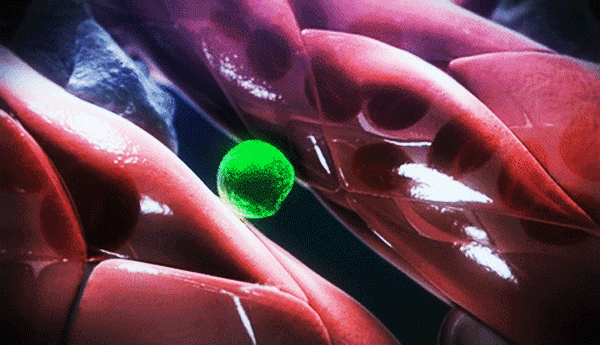
Source: UK Research and Innovation
Summary: Scientists have developed the first cells that can construct artificial polymers from building blocks that are not found in nature, by following instructions the researchers encoded in their genes. The study also found the synthetic genome made the bacteria entirely resistant to infection by viruses.
The study, led by scientists from the Medical Research Council (MRC) Laboratory of Molecular Biology, in Cambridge, UK, also found the synthetic genome made the bacteria entirely resistant to infection by viruses.
The scientists say their research could lead to the development of new polymers - large molecules made of many repeating units, such as proteins, plastics, and many drugs including antibiotics - and make it easier to manufacture drugs reliably using bacteria.
The research, published today in the journal Science, builds on previous ground-breaking work by the team when, in 2019, they developed new techniques to create the biggest ever synthetic genome - constructing the entire genome of the bacterium Escherichia coli (E.coli) from scratch.
Using cells' natural protein-making processes
The scientists' goal was to utilise their new technology to create the first cell that can assemble polymers entirely from building blocks that are not found in nature.
Proteins are a type of polymer, so the scientists aimed to make artificial polymers by exploiting cells' natural protein-making processes.
The genetic code instructs a cell how to make proteins, which are constructed by joining together strings of natural building blocks, called amino acids.
The genetic code in DNA is made up of four bases, represented by the letters: A, T, C and G. The four letters in DNA are “read” in groups of three letters - for example “TCG” - which are called a “codon”.
Each codon tells the cell to add a specific amino acid to the chain - it does this via molecules called “tRNA”. Each codon has a specific tRNA that recognises it and adds the corresponding amino acid, for example: the tRNA that recognises the codon “TCG”, brings the amino acid serine.
With four letters in groups of three, there are 64 possible combinations of letters; however, there are only 20 different natural amino acids that cells commonly use. So, several different codons can be synonymous - they all code for the same amino acid - for example: TCG, TCA, AGC and AGT all code for serine.
There are also codons which tell a cell when to stop making a protein, such as TAG and TAA.
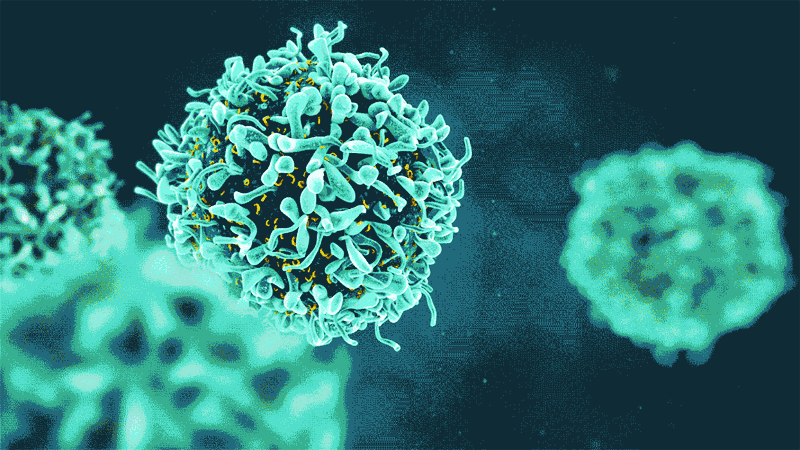
Re-writing the whole genome
When, in 2019, the team at the MRC Laboratory of Molecular Biology created the first entire genome synthesised from scratch for the commonly studied bacteria, E. coli, they also took the opportunity to simplify its genome.
They replaced some of the codons with their synonyms: they removed every instance of TCG and TCA and replaced them with the synonyms AGC and AGT.
They also removed every instance of the “stop” codon TAG and replaced it with its synonym TAA.
The modified bacteria no longer had the codons TCG, TCA and TAG in their genome, but they could still make normal proteins and live and grow.
Resistant to viruses
Now, in their latest research, the scientists have further modified the bacteria to remove the tRNA molecules that recognise the codons TCG and TCA. This means that - even if there are TCG or TCA codons in the genetic code - the cell no longer has the molecule that can read those codons.
This is fatal for any virus that tries to infect the cell, because viruses replicate by injecting their genome into a cell and hijacking the cell's machinery. Virus genomes still contain lots of the TCG, TCA and TAG codons, but the modified bacteria are missing the tRNAs to read these codons.
When the machinery in the modified bacteria tries to read the virus genome, it fails every time it reaches a TCG, TCA or TAG codon.
In this study, the researchers infected their bacteria with a cocktail of viruses. Unmodified normal bacteria were killed by the viruses, but the modified bacteria were resistant to infection and survived.
Making bacteria resistant to viruses could make manufacturing certain types of drugs more reliable and cheaper. Many drugs - for example, protein drugs, such as insulin, and polysaccharide and protein subunit vaccines - are manufactured by growing bacteria which contain instructions to produce the drug.
Professor Jason Chin, from the MRC Laboratory of Molecular Biology, who led the study, said:
“If a virus gets into the vats of bacteria used to manufacture certain drugs then it can destroy the whole batch. Our modified bacterial cells could overcome this problem by being completely resistant to viruses. Because viruses use the full genetic code, the modified bacteria won't be able to read the viral genes.”
Living factories for synthetic polymers
By creating bacteria with synthetic genomes that do not use certain codons, the researchers had freed up those codons to be available to be used for other purposes, such as coding for synthetic building blocks, called monomers.
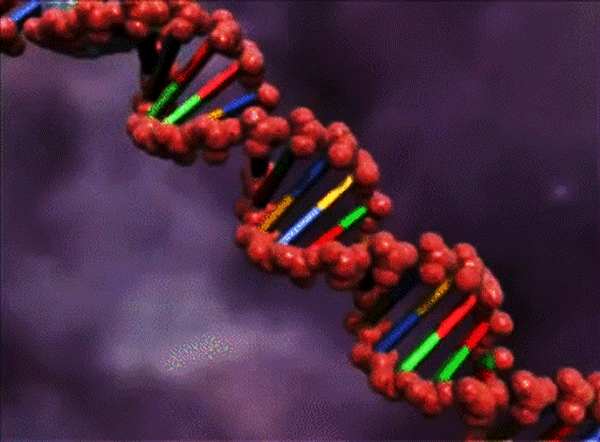
Professor Chin said:
“This system allows us to write a gene that encodes the instructions to make polymers out of monomers that don't occur in nature.”
“These bacteria may be turned into renewable and programmable factories that produce a wide range of new molecules with novel properties, which could have benefits for biotechnology and medicine, including making new drugs, such as new antibiotics.”
“We'd like to use these bacteria to discover and build long synthetic polymers that fold up into structures and may form new classes of materials and medicines. We will also investigate applications of this technology to develop novel polymers, such as biodegradable plastics, which could contribute to a circular bioeconomy.”
They engineered the bacteria to produce tRNAs coupled with artificial monomers, which recognised the newly available codons (TCG and TAG).
They inserted genetic sequences with strings of TCG and TAG codons into the bacteria's DNA. These were read by the altered tRNAs, which assembled chains of synthetic monomers in the sequence defined by the sequence of codons in the DNA.
The cells were programmed to string together monomers in different orders by changing the order of TCG and TAG codons in the genetic sequence.
Polymers composed of different monomers were also made by changing which monomers were coupled to the tRNAs.
The researchers were able to create polymers made of up to eight monomers strung together. They joined the ends of these polymers together to make macrocycles - a type of molecule that form the basis of some drugs, such as certain antibiotics and cancer drugs.
In this study, the synthetic monomers were linked together by the same chemical bonds that join together amino acids in proteins, but the researchers are investigating how to expand the range of linkages that can be used in the new polymers.
Dr Megan Dowie, head of molecular and cellular medicine at the Medical Research Council, which funded the study, said:
“Dr Chin's pioneering work into genetic code expansion is a really exciting example of the value of the MRC's long-term commitment to discovery science. Research like this, in synthetic and engineering biology, has huge potential for major impact in biopharma and other industrial settings.”
Science Daily (06/03/2021) 


SONG FACTS
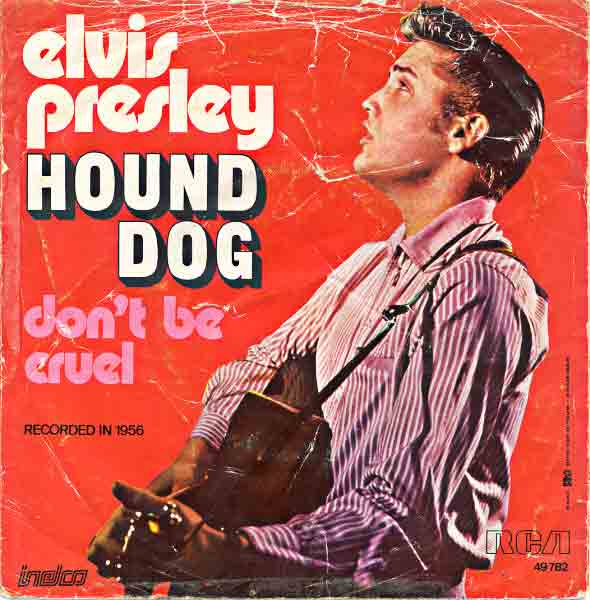
“Hound Dog”  - Elvis Presley
- Elvis Presley
Album: Elvis' 30 #1 Hits
Released 1956 
“Hound Dog”  was originally recorded in a blues style by Big Mama Thornton in 1953.
“Her version”
was originally recorded in a blues style by Big Mama Thornton in 1953.
“Her version”  was a #1 R&B hit and by far her biggest success. Like many blues musicians, she never made much money, but was a big influence on many singers who did.
In 1968, Janis Joplin recorded a song Thornton wrote called
“Ball and Chain”
was a #1 R&B hit and by far her biggest success. Like many blues musicians, she never made much money, but was a big influence on many singers who did.
In 1968, Janis Joplin recorded a song Thornton wrote called
“Ball and Chain”  , which appeared on several Joplin compilation albums after she died in 1970.
, which appeared on several Joplin compilation albums after she died in 1970.
Elvis' version of this song is based on how he heard it
“performed by a Texas group”  called Freddie Bell and The Bell Boys, who released the song on the Teen label in 1955. In April 1956, Elvis was booked for two weeks at The New Frontier Hotel in Las Vegas. One night, Elvis and his band explored the Vegas strip and landed at the Sahara, where Freddie Bell and The Bell Boys were performing in the lounge. When they performed their comedic version of “Hound Dog”, Elvis was impressed and decided to do his own in a similar vein.
called Freddie Bell and The Bell Boys, who released the song on the Teen label in 1955. In April 1956, Elvis was booked for two weeks at The New Frontier Hotel in Las Vegas. One night, Elvis and his band explored the Vegas strip and landed at the Sahara, where Freddie Bell and The Bell Boys were performing in the lounge. When they performed their comedic version of “Hound Dog”, Elvis was impressed and decided to do his own in a similar vein.
Elvis used the same lyrics, which differed from the Big Mama Thornton
“original”  . In this approach to the song, Elvis is acting disappointed with his lover and repeating the lyrics,
. In this approach to the song, Elvis is acting disappointed with his lover and repeating the lyrics,
“Well, they said you was high-classed, but that was just a lie” six times. In Thornton's original, she sings the line twice as “You told me you was high class, but I can see through that.”
This was one of the first big hits for the songwriting team of Jerry Leiber and Mike Stoller, who were teenagers when they wrote it. Based on the success of “Hound Dog”, Leiber and Stoller were hired to write many more songs for Elvis, as well as the score for his movie “Jailhouse Rock”  (including the famous title song).
(including the famous title song).
Working for Elvis was very good for Leiber and Stoller, but they didn't like what he did with “Hound Dog”.
“It was nervous sounding”, Leiber said in More Songwriters on Songwriting. “It didn't have that insinuation that Big Mama's
“record”  had.”
had.”
Stoller added, “It's something that really is sort of an imitation that never really turned out well.”
In a 2001 talk with Rock's Backpages,
Leiber and Stoller explained that they thought of themselves as black, and were always surprised when they passed by a mirror. They went on to explain what it was like writing and recording
“this song”  with Big Mama Thornton.
with Big Mama Thornton.
Says Leiber: “We'd actually written ‘Hound Dog’ 90 percent on the way over in the car. I was beating out a rhythm we called the 'buck dance' on the roof of the car. We got to Johnny Otis's house and Mike went right to the piano... didn't even bother to sit down. He had a cigarette in his mouth that was burning his left eye, and he started to play the song. We took the song back to Big Mama and she snatched the paper out of my hand and said, 'Is this my big hit?' And I said, 'I hope so.'
Next thing I know, she starts crooning ‘Hound Dog’ like Frank Sinatra would sing ‘In The Wee Small Hours of the Morning’. And I'm looking at her, and I'm a little intimidated by the razor scars on her face, and she's about 280-320 pounds, and I said, ‘It don't go that way’. And she looked at me like looks could kill and said - and this was when I found out I was white - ‘White boy, don't you be tellin' me how to sing the blues.’ We finally got through it.
Johnny brought Mike back in the room and asked him to sit down at the piano, which was not easy because Johnny had this female piano player who was built like Arnold Schwarzenegger. They finally exchanged seats and did the song the way it was supposed to sound. And that was one of those where we said, ‘That's a hit!’ And I thought immediately: We both said it, it's gonna put a hex on it!”
The Big Mama Thornton original version was the first song that Leiber and Stoller produced. Mike Stoller told Mojo magazine April 2009 what happened:
“Johnny Otis was supposed to run the session. We had rehearsed and he'd played drums. When we got in the studio (it was) his regular drummer. It wasn't happening. I said, ‘Johnny, you've got to play the drums, do what you did in rehearsal.’ So he said, ‘Who's going to run the session.’ I said, ‘We will.’”
When the line “You ain't nothin' but a hound dog” popped into Jerry Leiber's head, he considered “hound dog” a placeholder phrase. “I wanted something that was a lot more insinuating”, he said in More Songwriters on Songwriting. “I wanted something that was sexy”.
His partner Mike Stoller liked it and convinced him to leave it as is.
“Hound Dog”  was released as a single with
“Don’t Be Cruel”
was released as a single with
“Don’t Be Cruel”  . It is the only single to have both sides reach #1 in the U.S. The single was #1 in the U.S. for 11 weeks, a record that was not broken until 1992 by
“End of the Road”
. It is the only single to have both sides reach #1 in the U.S. The single was #1 in the U.S. for 11 weeks, a record that was not broken until 1992 by
“End of the Road”  by Boyz II Men.
by Boyz II Men.
Regarding the #1 chart positions of the single, Joel Whitburn, who writes the definitive books on the subject, told the Forgotten Hits newsletter:
“As far as the two-sided Presley hit ‘Hound Dog’” / “‘Don't Be Cruel’, I've always tabulated that single 45 as two #1 hits. ‘Hound Dog’ was the first title to chart and the first one to be listed as the lead #1 song.
Billboard's ‘Best Sellers in Stores’ chart listed the the #1 song on 8/18/56 as ‘Hound Dog/Don't Be Cruel’.It was also shown that way when it first topped the ‘Most Played in Juke Boxes’ chart on 9/1/56. There is absolutely no doubt that the initial sales and ‘buzz’ about this record was for ‘Hound Dog’.
It was a smash #1 hit right out of the box. As airplay began to favor ‘Don't Be Cruel’, the two titles were flip-flopped at #1, with ‘Don't Be Cruel’ actually showing more weeks as the #1 lead song.
Again, I have always tabulated these two titles as two #1 songs. There is no way you can consider this 4-times platinum record as one #1 hit. And, neither does RIAA who awards gold and platinum selling records. They show ‘Hound Dog’ / ‘Don't Be Cruel’ as both receiving platinum designations.”
In 1958, the
“Hound Dog”  /
“Don’t Be Cruel”
/
“Don’t Be Cruel”  single became just the third record to sell more than 3 million copies, following Bing Crosby's
“White Christmas”
single became just the third record to sell more than 3 million copies, following Bing Crosby's
“White Christmas”  and Gene Autry's
“Rudolph The Red-Nosed Reindeer”
and Gene Autry's
“Rudolph The Red-Nosed Reindeer”  .
.
After writing this song with Jerry Leiber, Mike Stoller got married and went on a trip to Europe. He was returning on the Italian ocean liner Andrea Doria in 1956 when it was rammed by another ship in fog off Nantucket Sound and eventually sank. Stoller and his new wife abandoned ship in a lifeboat and were rescued. About 50 of the 1,500 people on board died. When Stoller arrived at the dock at New York, Leiber was there to welcome him with the news that they had their first major hit with “Hound Dog”, by a newcomer called Elvis Presley.
In a Rock's Backpages interview, Stollerrecounts,
”He assumed I was soaked, if I was alive. But he said, ‘We got a smash hit on ‘Hound Dog’.’ And I said, ‘Big Mama's record?’ And he said, ‘No. Some white guy named Elvis Presley.’ And I heard the record and I was disappointed. It just sounded terribly nervous, too fast, too white. But you know, after it sold seven or eight million records it started to sound better. I should also say that the other things we did with Elvis I liked very much.”
Presleys guitarist Scotty Moore played on a P-90-equipped Gibson L-5 plugged into a Ray Butts amp.
There are two guitar solos in the song, and at the beginning of the second one, Moore made some sounds that guitarists have been unable to replicate since. Moore claimed that he didn't even know how he did it, making it one of the great guitar mysteries in rock.
Elvis and his his band recorded
“Hound Dog”  and
“Don’t Be Cruel”
and
“Don’t Be Cruel”  on July 2, 1956. It was a grueling session, with Elvis working himself and the band through an increasingly focused 31 takes. The sessions took place at RCA's studios in New York.
on July 2, 1956. It was a grueling session, with Elvis working himself and the band through an increasingly focused 31 takes. The sessions took place at RCA's studios in New York.
Elvis performed this song twice on national TV before he recorded it.
“The first performance”  was on The Milton Berle Show, June 5, 1956, which is where Elvis learned that hamming the song up as much as possible would get a huge reaction.
was on The Milton Berle Show, June 5, 1956, which is where Elvis learned that hamming the song up as much as possible would get a huge reaction.
“The next performance”  was on the much more staid The Steve Allen Show on July 1, the day before they recorded the song. For this appearance, Elvis sang to a Basset Hound. He was not allowed to dance on the show, since Allen ran a family friendly program and Elvis' pelvis was not considered family friendly.
was on the much more staid The Steve Allen Show on July 1, the day before they recorded the song. For this appearance, Elvis sang to a Basset Hound. He was not allowed to dance on the show, since Allen ran a family friendly program and Elvis' pelvis was not considered family friendly.
On the UK show Songbook Leiber and Stoller were asked what they thought of the Elvis version when they first heard it. Stoller said:
“I thought it was nervous and too fast and they changed the words, some of them, because obviously the original lyric was a woman's song. I don't think they improved upon Jerry's lyrics.”
Leiber: “Oh, I thought it ruined the song. It was a song that had to do with obliterated romance. In effect, she was saying, 'Get out of my house.' And 'you ain't caught a rabbit, and you ain't no friend of mine' is inane. It doesn't mean anything to me.”
Stoller: “I agree with you and I always did. Except that after Elvis's record sold about 7 or 8 million the first release, I began to see some merit in it. (laughing)”
Asked what some of the original lyrics were, Leiber said,
“You ain't nothin' but a hound dog, quit snoopin' 'round my door. You ain't nothin' but a hound dog, quit snoopin' 'round my door. You can wag your tail, I ain't gonna feed you no more. You told me you was high class, but I can see through that.”
Especially in his later years, Elvis didn't like performing this live. At many of his shows, he rushed through the song or did a very short version.
“Hound Dog”  was inducted into the Grammy Hall of Fame in 1988.
was inducted into the Grammy Hall of Fame in 1988.
“Hound Dog”  was featured on the popular soundtrack to the 1994 movie Forrest Gump. In the movie, a pre-fame Elvis stays at the Gump boarding house and sings the tune for young Forrest, whose stilted dance moves inspire the singer's famous hip thrusts.
was featured on the popular soundtrack to the 1994 movie Forrest Gump. In the movie, a pre-fame Elvis stays at the Gump boarding house and sings the tune for young Forrest, whose stilted dance moves inspire the singer's famous hip thrusts.
MORE SONGS
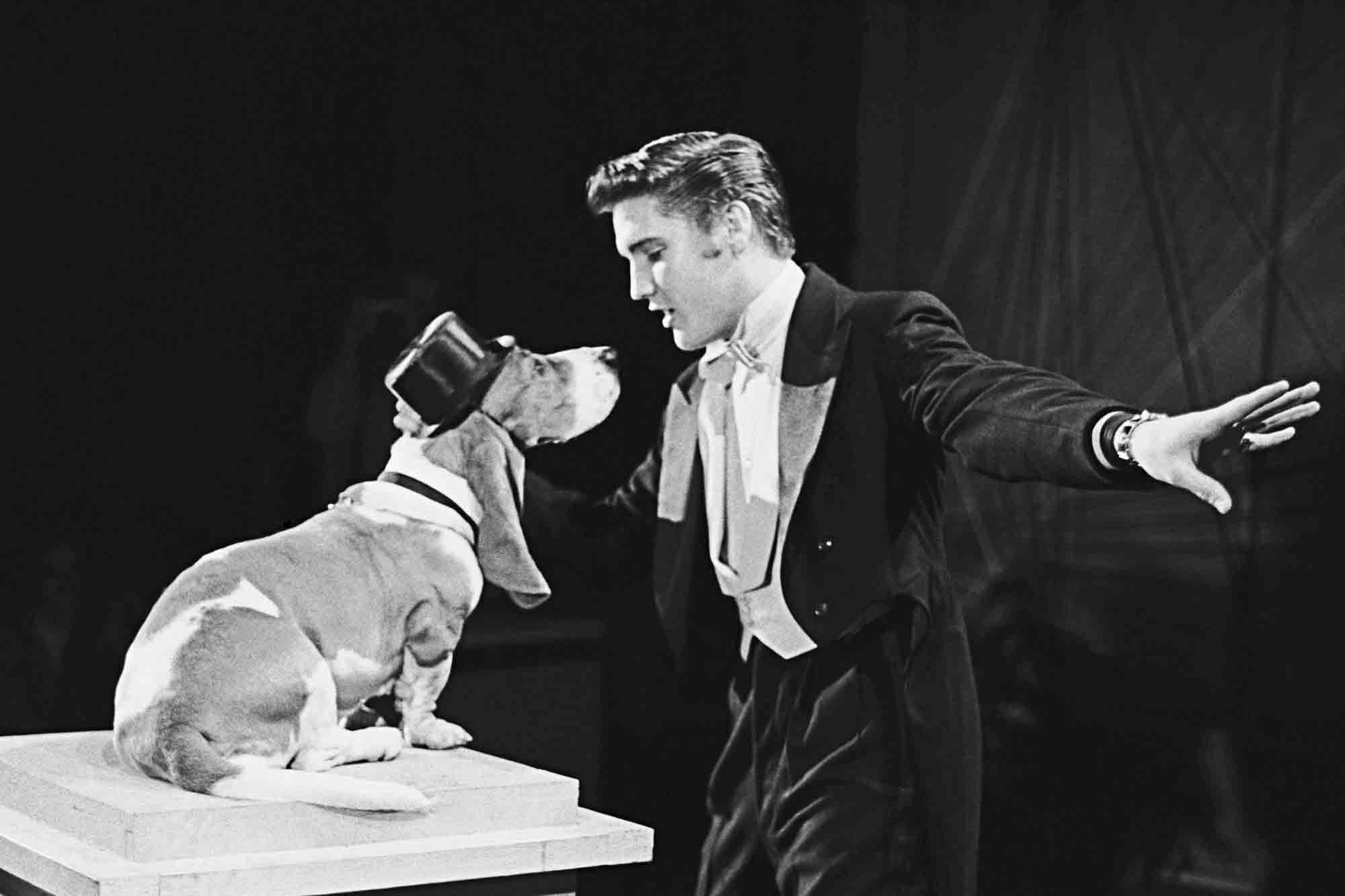
“Blue Suede Shoes” (1956) 
“Don’t Be Cruel” (1956) 
“Heartbreak Hotel” (1956) 
“Love Me Tender” (1956) 
“All Shook Up” (1957) 
“Jailhouse Rock” (1957) 
“(Let Me Be Your) Teddy Bear” (1957) 
“Too Much” (1957) 
“One Night” (1958) 
“It’s Now Or Never” (1960) 
“Are You Lonesome Tonight?” (1960) 
“Fever” (1960) 
“Can't Help Falling In Love” (1961) 
“Little Sister” (1961) 
“Return To Sender” (1962) 
“Crying In The Chapel” (1965) 
“Burning Love” (1972) 
“Steamroller Blues” (1972) 
Elvis Presley, official site (Elvis Presley Discography) / Rock & Roll Hall of Fame / Billboard / All Music / Song Facts / Ultimate Classic Rock / Wikipedia
Image: “Elvis' 30 #1 Hits (album)” by Elvis Presley

Trivia
● What is the International Space Station’s average distance from Earth?
Answer to Trivia
READ MORE: Space.com
● What is the function of the Thyroid Gland?
Answer to Trivia
READ MORE: National Center for Biotechnology Information.gov
● A June bug is what type of insect?
Answer to Trivia
READ MORE: Britannica
● In Star Wars, what was the vulnerable spot on the Death Star?
Answer to Trivia
READ MORE: Starwars.Fandom
● What was the name of Sherlock Holmes' intelligent brother?
Answer to Trivia
READ MORE: Bakerstreet.Fandom
READ MORE: Rotten Tomatoes

A Test for People Who Know Everything
From the Jeopardy Archives Category - “MOTOR TREND CAR OF THE YEAR” ($200)
“2004: This pioneering Toyota model.”
Answer to Jeopardy READ MORE: Motor Trend
From the Jeopardy Archives Category - “MOTOR TREND CAR OF THE YEAR” ($400)
“2018: This maker's Giulia was the alfa dog.”
Answer to Jeopardy READ MORE: Motor Trend
From the Jeopardy Archives Category - “MOTOR TREND CAR OF THE YEAR” ($600)
“1984: This Chevy sports car, about 30 years overdue.”
Answer to Jeopardy READ MORE: Motor Trend
From the Jeopardy Archives Category - “MOTOR TREND CAR OF THE YEAR” ($800)
“In 2001: This Chrysler ‘tall sedan’.”
Answer to Jeopardy READ MORE: Motor Trend
From the Jeopardy Archives Category - “MOTOR TREND CAR OF THE YEAR” ($1,000)
“1958: This sporty pre-Mustang Ford.”
Answer to Jeopardy READ MORE: Automotive Mile Posts
Joke of the Day

“It Was Many Years Ago”
Butcher And The Baby
It was many years ago since the embarrassing day when a young woman, with a baby in her arms, entered his butcher shop and confronted him with the news that the baby was his and asked what was he going to do about it?
Finally he offered to provide her with free meat until the boy was 16. She agreed.
He had been counting the years off on his calendar, and one day the teenager, who had been collecting the meat each week, came into the shop and said, “I'll be 16 tomorrow.”
“I know,” said the butcher with a smile, “I've been counting too, tell your mother, when you take this parcel of meat home, that it is the last free meat she'll get, and watch the expression on her face.”
When the boy arrived home he told his mother.
The woman nodded and said, “Son, go back to the butcher and tell him I have also had free bread, free milk, and free groceries for the last 16 years and watch the expression on his face!”

































